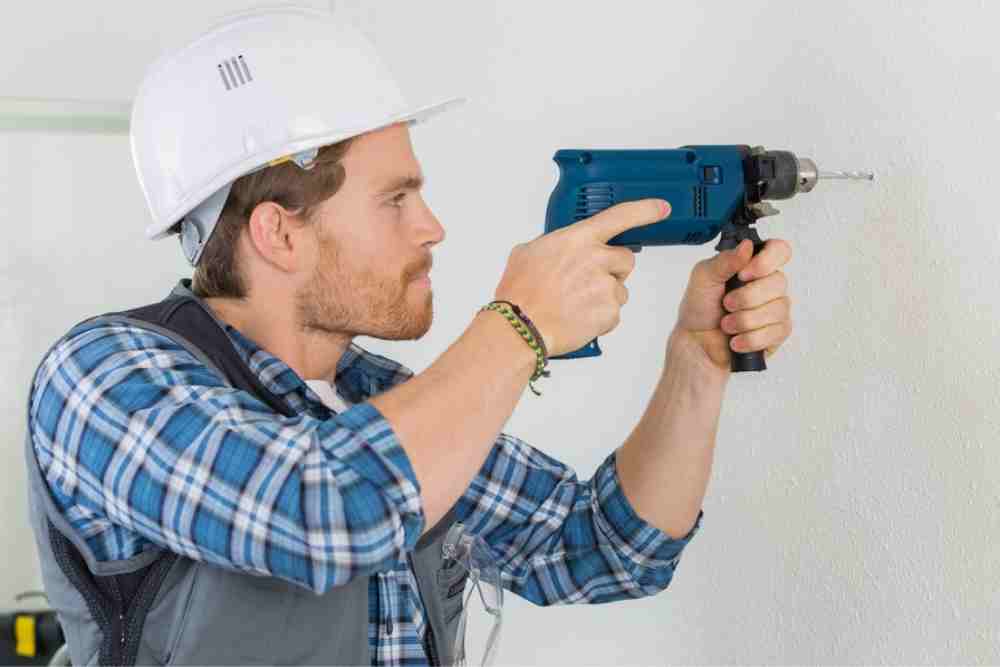Drilling into concrete can seem like a daunting task, but with the right tools and instructions, it can be a breeze. Here is a guide on how to drill into concrete.
In this article, we will explore some tips and tricks for drilling into concrete. First, we will look at the different types of drill bits that are best suited for this task.
Then, we will discuss how to use these bits to achieve the best results. Finally, we will provide some tips for avoiding common mistakes.

How To Drill Into Concrete?
Concrete is a popular building material for a variety of reasons, but one of its main drawbacks is that it can be difficult to drill through.
Step-1) Mark out the area of drilling
Mark out the area of drilling while being conscious of the pipework, wiring, or ductwork that is in the area.
Step-2) Place the depth stop
Place the depth stop 1/4 inch longer than needed for accessing the whole; (In case your drill doesn’t have a depth stop, you can also take blue painter’s tape and use it instead to measure the correct length on the drill bit and then place a piece of blue painter’s tape on that point of the drill, so you know what to stop drilling.)
Step-3) Pick the drill with the right size
Pick the drill with the right size carbide masonry drill bit.
Step-4) Separate the bit by positioning
Separate the bit by positioning it at the lowest speed until 1 4-inch depth is reached, using the least force possible to avoid making a hole in the drill bit.
Step-5) Blow the dust out
Blow the dust out of the guide hole with a shop-vac or blow across the gap.
Step-6) Drill the screw
Drill the screw into the hole at medium speed until the desired depth has been reached, keeping in mind to clear debris or vacuum it from the hole when necessary.
Types of Drill Bits that are Best Suited for this Task
If you plan on drilling into concrete, then you want to utilize a concrete or masonry drilling bit, since these bits are designed and engineered specifically to cut through concrete, masonry, brick, and stone.
The bodies of concrete and masonry drill bits are extremely durable, made from stainless-steel or tungsten carbide metals, which can withstand a long drilling into rock without dulling or breakage.
Tips for Avoiding Common Mistakes
When using a drill for concrete, there are some common mistakes that people make. Here are some tips for avoiding those mistakes:
-Make sure the drill bit is the correct size for the hole you are trying to drill. If it is too small, the bit will break and if it is too large, the hole will be too big.
Make sure the drill bit is the correct size for the hole you’re drilling. A bit that’s too small will cause the drill to overheat, while a bit that’s too large can damage the concrete.
-Always use lubricant when drilling into concrete. This will help to keep the bit cool and prevent it from breaking.
-Don’t try to drill through concrete that is too thick. Choose a drill bit that is appropriate for the thickness of the concrete you are trying to drill through.
-Don’t apply too much pressure when drilling into concrete. This can cause the bit to break or spin out of control.
Don’t apply too much pressure when drilling. This can cause the drill to break or become lodged in the concrete.
-Be patient and take your time when drilling into concrete.
-Keep the drill moving while drilling. If you stop drilling, heat will build up and could damage both the drill and the concrete.
-Be careful not to hit metal or other objects hidden in the concrete while drilling. This can cause damage to both your drill and whatever you hit.
Final Words
If you’re looking to drill into concrete, you’ll need to use a hammer drill and a concrete bit. Place the bit on the drill and make sure it’s firmly attached.
Hold the drill with one hand and use the other hand to guide it as you hit it with a hammer. Strike the drill at an angle and continue until the hole is deep enough.